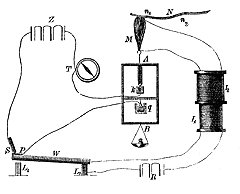|
|
|
Helmholtz's 'psychological' time experimentsHenning Schmidgen Amongst historians of physiology, it is understood that Hermann von Helmholtz's (1821-1894) work on the propagation speed of nervous stimuli constitutes the beginning of a branch of research that, in the following years and decades, became known as 'nerve and muscle physics' and, in more recent times, has been labeled 'neurophysiology' (Helmholtz 1850a; 1852).
Scholars such as Gabriel Gustav Valentin and Albert von Bezold, Julius Bernstein and Étienne Jules Marey, Keith Lucas and Edgar Douglas Adrian contributed significantly to this field. Less widely known is the fact that Helmholtz was interested in the time relations structured by the nervous systems of living beings not just from a physiological but also from a psychological point of view. In fact, at the time at which he performed his time experiments in frogs, Helmholtz carried out similar studies in human beings. Reference: Schmidgen, Henning. 2003. Helmholtz's "Psychological" Time Experiments.. The Virtual Laboratory (ISSN 1866-4784), https://vlp.mpiwg-berlin.mpg.de/references?id=art10 |
||

